Bowling Took a Beating on Twitter this Week. Here's Why (and What's Being Done about It).
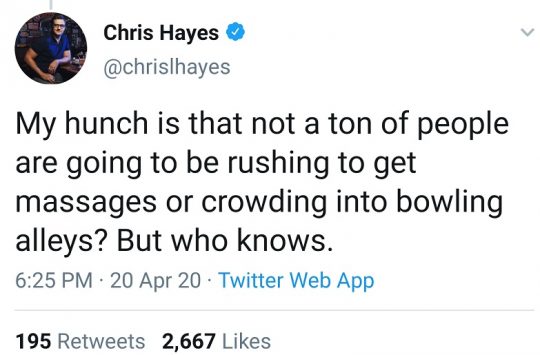
Any day on which tens of thousands of people are tweeting about bowling all at once is a great day for the sport, right? Well, except when many of them are tweeting things like this:

The reason bowling became one of the most trending topics on Twitter Monday afternoon with, at one point, more than 33,000 people having tweeted about the sport over a matter of hours, was that Georgia Governor Brian Kemp had just announced that, "Given the favorable data, enhanced testing, and approval of our healthcare professionals, we will allow gyms, fitness centers, bowling alleys, body art studios, barbers, cosmetologists, hair designers, nail-care artists, aestheticians, their respective schools, and massage therapists to reopen their doors this Friday."
Kemp emphasized in his announcement that businesses being allowed to reopen should “adhere to the minimum basic operations,” which included “screening workers for fever and respiratory illness, enhancing workplace sanitation, wearing gloves and masks if appropriate, separating work spaces by at least six feet, teleworking where at all possible, and implementing staggered shifts.”
Still, his decision to reopen some businesses prompted a backlash among a number of media personalities, bestselling authors and other high-profile people throughout Twitter who have millions of followers combined and took aim specifically at bowling, while many notable news and politics outlets carried the story.
Many of their takes advanced stereotypical characterizations of bowling centers (of course, most of the tweets featured here call them "bowling alleys") as places where germs fester and social distancing is impossible. While their tweets underscored an ignorance of the extent to which bowling proprietors plan to make customer and employee safety the utmost priority in a post-pandemic marketplace (as it already was prior to COVID-19), they also exemplify the kinds of perceptions the bowling industry needs to address in such an environment.
A couple cases in point . . .
Will Bunch, national opinion columnist for the Philadelphia Inquirer, told his 57,000 Twitter followers that, "most Americans would rather live than go bowling." Howard Fineman of NBC News and RealClearPolitics quipped that a "pandemic drone" currently in development in Connecticut to monitor COVID-like symptoms was "soon to be hovering over #Georgia bowling alleys."
In short, Monday was a tough day for bowling on Twitter, and a lot of people were chiming in or at least watching the reaction unfold. How many of those people potentially are the kind of recreational bowlers that proprietors hope to welcome back to their centers post-pandemic? It is a question those with any stake in bowling's future might want to contemplate. (Politics publication The Hill, for instance, drew more than 800,000 views of the video clip of Kemp's announcement that "bowling alleys" would be among the kinds of businesses he would permit to reopen.)
On Wednesday, President Trump said during the evening's White House press briefing that, "I told the Governor of Georgia Brian Kemp that I disagree strongly with his decision to open certain facilities which are in violation of the phase one guidelines." Trump's allusion to "guidelines" refers to the White House's phased "Opening Up America Again" guidelines, which can be read here. Longtime Director of the National Institute of Allergy and Infectious Diseases Dr. Anthony Fauci said in the same press briefing that, "I would advise not to do that." As of Wednesday, Georgia had seen 21,102 confirmed COVID-19 cases and 846 deaths.
At some point, though, bowling centers are going to reopen--not just in one state but across the country. And when they do, the perceptions aired by critics of Governor Kemp's decision on twitter this week will be just as pressing a concern for proprietors.
Here is a sampling of other tweets by those with sizable followings on the platform . . .
Vanity Fair (4.8 million followers): Asserts that "bowling alleys" are "places where people spread their germs" and Governor Kemp is among nation's "dumbest Governors" for reopening them this week . . .
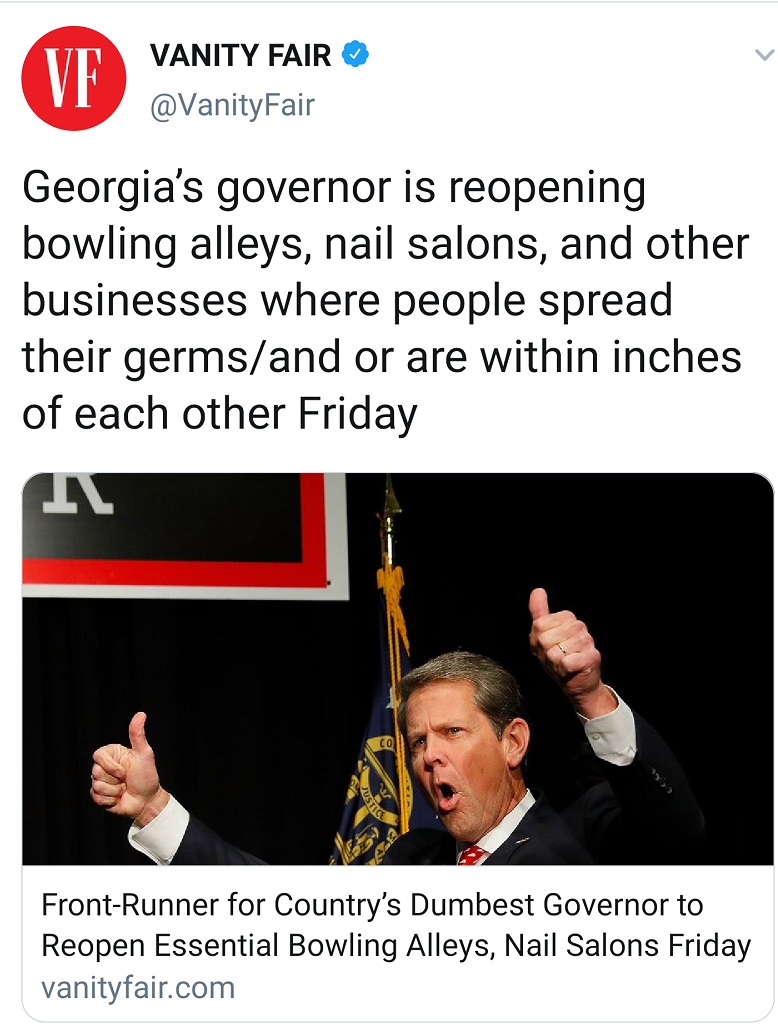
Bestselling author Tony Schwartz (252,000 followers): Suggests reopening "bowling alleys" will contribute to a surge in COVID-19 cases . . .
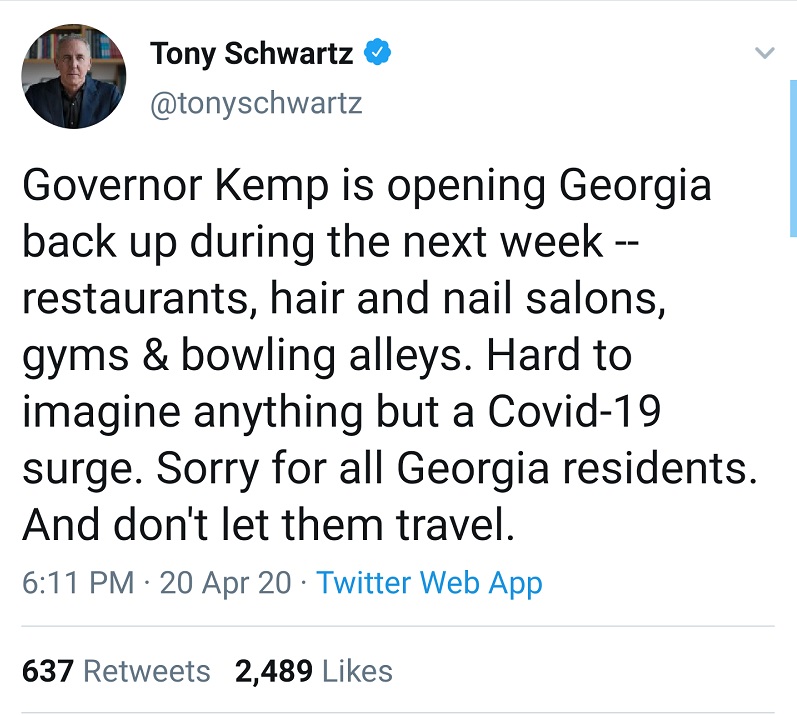
Daily Beast Politics Editor Sam Stein (463,000 followers): Asserts that "bowling alleys" are "based around folks putting their hands on a ball, rolling it, then someone else grabbing it" . . .

Author Saeed Jones (150,000 followers): Says reopening businesses such as "bowling alleys" is "concerning, crazy and scary" . . .

Famed Attorney Laurence Tribe (828,000 followers): Equates reopening "bowling alleys and tattoo parlors" with murder . . .

Singer Ricky Davila (300,000 followers): Suggests that reopening businesses such as "bowling alleys" is akin to "mass murder" . . .
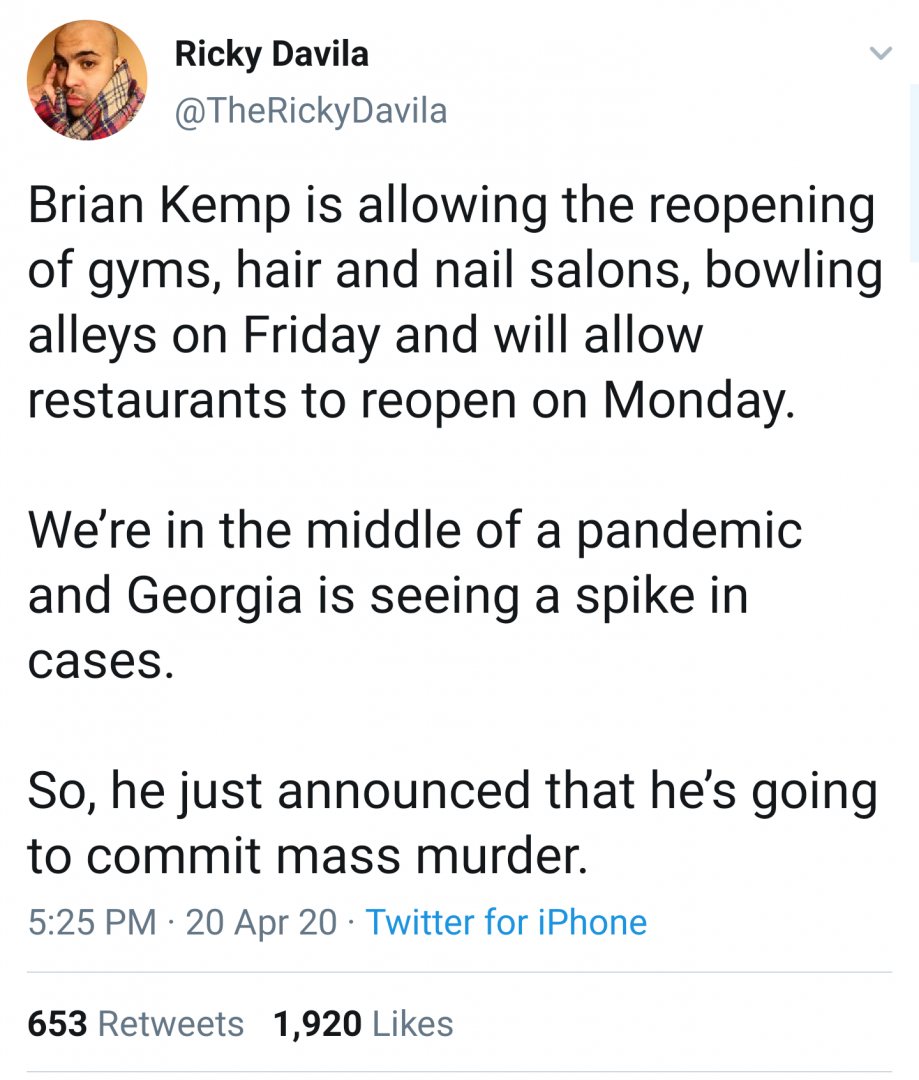
MSNBC Anchor Katy Tur (725,000 followers): Says she doesn't know how one practices social distancing in bowling centers due to "shared bowling balls" . . .
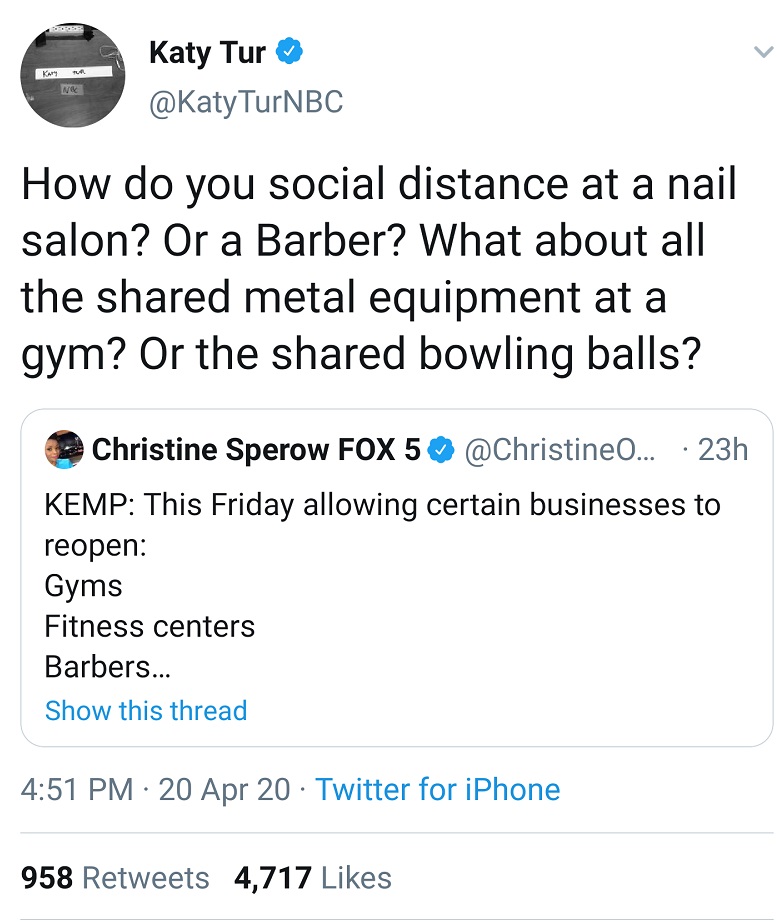
Sportswriter Jeff Schultz (34,000 followers): Says he is adding bowling to a list of activities in his "Dumbass Georgia Decathlon" . . .

MSNBC Anchor Chris Hayes (2.1 million followers): Says he doubts "a ton of people are going to be ... crowding into bowling alleys" . . .

The furor made its way into Tuesday's White House press briefing, where a reporter asked Dr. Deborah Birx for her thoughts on Governor Kemp's decision to reopen bowling centers, among other establishments, in Georgia this week. You can watch her response here. When MSNBC's Chuck Todd asked Atlanta Mayor Keisha Bottoms what she expects Atlanta residents to do on Friday, the day Governor Kemp's loosening of the state's lockdown protocols begins, she said, in part, that, "There's nothing essential about going to a bowling alley in the middle of a pandemic."
Perhaps not. But, as some of the country's most respected proprietors argue, there also is nothing essential about equating the reopening of bowling centers with mass murder. Some of the nation's most respected proprietors, including Don MacBrayne, John Losito, Mike Logan and Frank Wilkinson, say that much more can and will be done in bowling centers to ensure the well-being of their guests as they reopen throughout the country in the coming months.
MacBrayne, owner and operator of three centers in Colorado collectively branded as "The Summit" that have been closed for 27 days, said that, when his centers reopen, "If we assign a customer lane 9, we're going to walk them to lane 9 with their rental shoes in a basket and a sanitary wipe for each pair--even though the shoes already will have been sanitized."
That is an aspect of his post-pandemic reopening plan MacBrayne equates with the current grocery-store experience.

"It's like when you go into Whole Foods," he says. "You know that they have sanitized those baskets, and yet they're going to do it right in front of you again, and they're going to give you so you can do it yourself, too. That way, the customer feels a little bit more confidence and knows that they're doing a good job."
Before MacBrayne's customers begin play at his centers after reopening, he says, "We will wipe down the ball rack, the automatic score pedestal, the couches and the tables with certified disinfectant that is certified to kill coronavirus bacteria.
"The three things that have to happen with sanitation," MacBrayne adds, "are that it has to be effective, it has to be visible, and the guest has to have some control over it. Once you do those three things, I think it will ease the phobias and the concerns."
MacBrayne says he also intends to space out bowlers across his centers with at least one "dark" pair of lanes between pairs.
"In our restaurants, it will be a matter of just picking up 40 percent of our chairs," MacBrayne says of further social distancing measures his centers will enact. "We have a lot of space in our restaurants, so if we eliminate 40 to 50 percent of our chairs, we will easily have six feet between groups of guests.
"In the game room, we want to stay well below fire-department capacities," MacBrayne adds. "If we have a capacity of 150, we'll probably keep it around 50, because I don't want people to be playing a game and have another guest looking over their shoulder waiting for that game to come available and then move in.
"Even though we have about 80 player positions in our game room, we'll probably only let 50 people in at a time. Guests will be able to go in, we'll stanchion it off like grocery stores do now, there'll be a table right there with some wipes and some gloves, and then we'll have two people in the room constantly just sanitizing games. It's optics, in that we want the guest to see us sanitizing the establishment."
MacBrayne says he is unlikely to open any laser tag arenas to start, because "It's just a little too complex to monitor."
What of those "shared house balls" Tur identified as a point of concern? You know, that one aspect of a bowling-center environment that makes Stein "crack up." MacBrayne and other proprietors say they will be adopting aggressive sanitization procedures for those, too.
"We'll ask them to leave their bowling balls and shoes at the lane when they're done," he says, "and we'll have a bowling ball sanitation station. We'll pick up the shoes and take them back to the counter and sanitize them, but we'll pick up the balls and take them to a sanitizing station right behind the lanes, which everybody's looking at, and sanitize those balls and put them on a clean rack. Even while they're bowling, they're going to see what happens after they leave."
That sanitization station for house balls "will involve the proper disinfectant in the proper bottle so guests can see that it's just not our recipe of what we think is disinfectant; it will be the certified COVID-sanitization product," he says. "We will spray inside the three finger holes, spray on the other side, spin the ball with a finger in each hole to dry it out and put it on a clean rack. That's our plan."
For MacBrayne, the point upon reopening his centers will not be to drum up business. Much more important, he says, will be doing everything possible to demonstrate to the communities his centers serve how much they care about the well-being of their guests.
"We have to earn, and win, the community's confidence," he says. "We own our real estate. We're there for the next 30 years. We're responsible with serving liquor. We do everything for every fundraiser there is. There's no need to get greedy in the eight weeks of June and July. There's just no need. Get the confidence up, tell them what we're doing, inform them of what the new business model is."

For MacBrayne, who has continued to pay the full salaries and benefits of all 25 of his full-time employees while his centers have been closed for nearly a month, that new business model very much includes protecting employee safety as well.
"I don't want our servers picking up dirty plates, so we'll have unique people who are responsible for running food, and unique people who are responsible for busing and picking up plates and glasses," he says.
The protection of his guests and employees is an even more personal concern for MacBrayne than it might be for other proprietors. He himself tested positive for COVID-19 on April 3.
"I had a headache for a day, and a little heaviness in the chest, and that heaviness in the chest is what caused me to go get checked out," he says. "They did the COVID test and six days later I found out it was positive."
He suspects he contracted it from his wife, who had been ill at the time.
"She was very sick for the two weeks prior . She manifested every symptom; you go down the list, she had it. But not to the point that she needed to get to the hospital. You know, this thing moves along so quickly that it's hard to remember that back on March 17, you couldn't get tested unless you were checked into a hospital."
MacBrayne did express concern about Governor Kemp's timeline, which essentially allowed proprietors 96 hours to amass all the supplies they will need to execute the kind of sanitization processes he and others are planning to enact in their centers. He said he would prefer to have at least a week-and-a-half.
John Losito, operator of Sun Valley Lanes in Lincoln, Neb., which has hosted numerous professional and collegiate bowling tournaments over the years, said, "As a facility operator, I always try to pride myself on the cleanliness of the facility, but this is, in reality, no different than any other activity where you're going to be touching something.
"Do we have procedures and protocols in place to make sure everything's clean? Absolutely. We had already started sanitizing tables and doing all sorts of stuff a long time ago. Especially during flu season, that's just kind of common sense."
Losito has a question for inhabitants of the Twitterverse who believe Georgians will be faced with choosing between life and bowling come Friday: "How are we any different than going to the amusement park or to a sporting stadium or to a movie theater or even on a golf course or going mini-golfing? Places where you're going to touch other things. We're no different than any other recreational facility or anywhere else you would go, including the grocery store."
"If you want to live in a bubble to be protected, absolutely, go live in a bubble," Losito adds. "But if you want to go out in the world, you have to be able to touch stuff."
Losito says the notion that social distancing is impossible within a bowling center is "wrong." He intends to space out bowlers across every other lane. That way, he says, "You'll get more than six feet between people because a pair of lanes is 11 feet wide. So automatically, by default, it will be that way. If we have to start with every fourth lane, or even every sixth lane, we'll do whatever it takes to make people feel comfortable both mentally and emotionally, let alone meet the standards of whatever the CDC or anybody else is recommending.
"I think that's actually pretty simple to do in a bowling center, because we determine where people go when it comes to lane assignments," Losito adds. "It's not like going to a movie theater or anywhere else where somebody could sit down next to you.
"I hear that's the thought with casinos, that they're going to open every other machine or every third machine. Nobody's blasting them for being a casino where people are smoking inside. We don't even allow smoking anymore .
"Are we going to take it slow? Absolutely. We're not just going to open our doors and expect people to come flying in and have this massive group of people," Losito says.
Logan, the 2019 Bowling Proprietors' Association of America proprietor of the Year and owner of Grand Station Entertainment in College Station, Texas, says, "My eyes and ears are peeled on what's going to happen . Georgia will be the test site for everybody, I guess. I am sure everybody's going to be watching that."

In the meantime, one change Logan intends to make echoes MacBrayne's plan. "We're going to ask our customers to leave their bowling balls on the rack. We've put together some roll carts that lane attendants will have as they go by, we will pick up the bowling balls ourselves and take them behind the counter where we'll have a little vat of alcohol or some sort of a sanitizing solution, dip them in there, put them out on a rack and let them dry out, and then we'll go put them back out ."
Above the racks, Logan says, his center will have hand sanitizer available and patrons will be encouraged to use it prior to the start of play.
"I think a lot of people in our community will be receptive to us opening back up again, as long as we show them that we are concerned about their health," he adds.
Former United States Bowling Congress President Frank Wilkinson, who owns and operates Rab's Country Lanes in Staten Island, N.Y., says that, before the pandemic forced the closure of bowling centers nation wide, many centers "created a public notice. We put it out. We stepped up our game when talking to our staff, retraining in certain cases.
"If somebody walks into a bowling center and instead of smelling whatever they are used to smelling, they smell cleaning products, you're setting up the sense that, 'Okay, it's clean,'" Wilkinson says. "But, at the center level, what are you doing to make sure the customer sees that it's clean? Can we truly change people's mindsets? I think we can.
"In our sport, yes, everybody high-fives, everybody hugs, everybody celebrates in their own fashion. I get that. Do we have rental shoes? Yes. We disinfect. Do we have rental balls people use? Without a doubt. But I can say confidently that, in our center and with our team, we went above and beyond to make sure, 'Okay, this experience will be a little bit different. Let's look at the space differently. Let's make sure we're sanitizing in front of people, spending more time doing it versus cleaning up a table and moving on to the next one. No. Let's take care of it right away.' For us, fortunately, that's part of our regular, everyday business."
That included sanitizing house balls. "The difference, though, was we weren't doing it in front of people," Wilkinson says. "We were doing it at off-beat times, making sure that we were cleaning equipment. So, for us, it's just like we started before we had to close. We were doing it in front of our customers so they were assured. When they were returning the bowling balls and bringing back their shoes, we were spraying the balls and the shoes."
As urgent as the customer's desire to see such sanitization procedures in action may be in a post-pandemic world, Wilkinson wonders if there also may be an unintended side effect of those measures.
"I wonder how far we can go without creating doubt," he says. "I think that's the other thing. The more things that we do, the more doubt we create in people. And what happens when we get comfortable and we stop doing it? What message does that send?"
For that reason, Wilkinson believes it will be important for proprietors to adopt sanitization protocols that are sustainable.
"Whatever processes we put in place have to be things that are long-term," he says. "In the short term, might we continue doing what we were doing before we closed at the front counter? Maybe. But I don't think that's sustainable and makes sense. I think if we continue to sanitize on a regular basis, move our off-peak hours to peak hours where people are seeing you do it, that's how we accomplish that task. It might cost us a little more in labor because you'll have to keep some people on longer to get the job done, but so be it."
Wilkinson acknowledges that bowling's return from this pandemic might involve "a slow start," but he also adds, "I do believe that people are itching to get out of their house and the first places they want to turn certainly are bowling centers. We can socially distance to an extent. It's going to look different. Is open bowling going to be every other lane? Every other pair? Are we probably not going to be able to have league bowling right away? Maybe not.
"I hope operators around the country will look at this as an opportunity to relook at their business and the way that we operate. Do we have enough staff to keep the place clean? Do we have processes in place to make sure that we are doing everything we can in that regard? If we're doing that, then the customer is going to see it and embrace that. I believe the customer is being retrained as they sit at home on how to go out in public."
For Wilkinson, the bottom line for bowling as it navigates its way through an unprecedented crisis for the industry is that, "People, even in the worst of times, still need to go out to their community venues to get away from everyday life and be a part of something."





